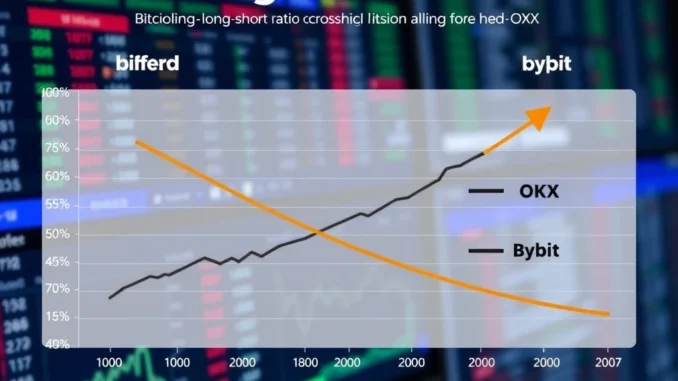
Ever wondered what the smart money is doing in the Bitcoin market? One powerful indicator savvy traders keep a close eye on is the BTC long-short ratio. It’s like peeking behind the curtain to see whether the majority are betting on Bitcoin going up (long) or down (short). Let’s dive into the latest 24-hour snapshot of these ratios for BTC perpetual futures across the leading cryptocurrency exchanges and decipher what they might be telling us about the current market sentiment.
Decoding the BTC Long-Short Ratio: A Key to Market Sentiment
So, what exactly is the BTC long-short ratio? In simple terms, it’s a comparison of the total volume of long positions versus short positions for Bitcoin perpetual futures contracts on a given exchange or across multiple exchanges. A ratio above 50% long indicates that more traders are positioned to profit from an upward price movement, while a ratio above 50% short suggests the opposite – more traders are expecting a price decrease. It’s a snapshot of collective trader sentiment at a specific moment in time.
Why is this ratio so crucial for anyone involved in perpetual futures trading? Because it offers a glimpse into the overall market bias. Here’s why tracking the BTC long-short ratio is beneficial:
- Gauge Market Sentiment: It provides a real-time view of whether the market is leaning bullish or bearish on Bitcoin. This can be incredibly helpful in understanding the prevailing mood and potential direction of price movements.
- Identify Potential Overextension: Extreme long or short ratios can sometimes signal market overextension. For instance, an overwhelmingly long ratio might suggest the market is becoming too bullish and could be ripe for a correction. Conversely, an extremely short ratio might indicate excessive fear and a potential bounce.
- Inform Trading Decisions: While not a standalone indicator, the BTC long-short ratio can be a valuable piece of the puzzle when making trading decisions. It can help confirm or challenge your own analysis and provide context to other technical and fundamental indicators.
24-Hour BTC Long-Short Ratio Snapshot: A Balanced Market?
Let’s take a look at the Bitcoin futures long-short ratios across major exchanges over the past 24 hours. This data gives us a consolidated view of the broader market sentiment.
Total Across Exchanges:
- Long Positions: 49.72%
- Short Positions: 50.28%
Overall, the numbers are remarkably balanced! With nearly a 50/50 split between long and short positions across all tracked exchanges, it suggests a market in equilibrium, or perhaps indecision. Neither bulls nor bears are overwhelmingly dominant at this moment. But let’s drill down into individual exchanges to see if there are any nuances.
Exchange-Specific Breakdown: Binance, OKX, and Bybit
Looking at individual exchanges can sometimes reveal localized sentiment shifts or trends. Here’s the breakdown for three of the top cryptocurrency exchanges:
Binance: Navigating a Slightly Bearish Tide?
- Long Positions: 49.4%
- Short Positions: 50.6%
On Binance, the world’s largest cryptocurrency exchange, we see a slightly higher percentage of short positions (50.6%) compared to long positions (49.4%). While the difference is marginal, it hints at a slightly bearish sentiment prevailing among Binance long-short ratio traders over the last 24 hours. Is this a precursor to broader market movement, or just typical exchange-specific fluctuation?
OKX: Mirroring the Overall Balance
- Long Positions: 49.86%
- Short Positions: 50.14%
OKX presents an almost identical picture to the overall average. The long-short ratio here is incredibly balanced, further reinforcing the idea of market equilibrium or indecision. Traders on OKX seem to be as divided as the broader market when it comes to their directional bets on Bitcoin.
Bybit: Leaning Slightly Short
- Long Positions: 49.36%
- Short Positions: 50.64%
Bybit, known for its derivatives trading platform, also shows a slight skew towards short positions, mirroring Binance’s sentiment. With 50.64% short positions, it again suggests a marginally bearish outlook among Bybit’s perpetual futures trading participants.
Interpreting the Data: What Does It All Mean?
While the 24-hour crypto market sentiment as reflected by the BTC long-short ratio appears balanced overall, the slight lean towards short positions on Binance and Bybit warrants attention. Here are a few possible interpretations:
- Minor Bearish Pressure: The slight edge in short positions across key exchanges could indicate a subtle bearish pressure in the market. Traders might be anticipating a short-term pullback or consolidation.
- Hesitation and Uncertainty: The overall balanced nature also suggests a degree of uncertainty. Traders may be hesitant to take strong directional positions, waiting for more clarity from broader market factors, economic news, or regulatory developments.
- Normal Market Fluctuations: It’s important to remember that these ratios fluctuate constantly. A slight shift to short positions over 24 hours might simply be within the normal range of market noise and not necessarily indicative of a major trend change.
Actionable Insights: How Traders Can Use This Information
So, how can you, as a trader, utilize this BTC long-short ratio data? Here are a few actionable steps:
- Monitor Trends Over Time: Don’t just look at a single snapshot. Track the BTC long-short ratio over days and weeks to identify developing trends. A consistent increase in short positions, for example, could signal a growing bearish sentiment.
- Combine with Other Indicators: Use the long-short ratio in conjunction with other technical analysis tools, on-chain metrics, and fundamental analysis. It should be part of a broader toolkit, not the sole basis for trading decisions.
- Be Aware of Exchange Differences: Pay attention to variations in ratios across different exchanges. Significant divergences could highlight specific exchange dynamics or localized sentiment shifts.
- Manage Risk: Regardless of the long-short ratio, always practice robust risk management. Use stop-loss orders, manage your position sizes, and never invest more than you can afford to lose.
Limitations to Consider
It’s crucial to acknowledge the limitations of relying solely on BTC long-short ratio data:
- Exchange Specificity: Ratios can vary significantly between exchanges. Data from one exchange might not perfectly reflect the sentiment on another.
- Lagging Indicator: Long-short ratios are often considered a lagging indicator. They reflect past positioning and may not always accurately predict future price movements.
- Manipulation Potential: In theory, large players could attempt to manipulate these ratios to create a false sense of market sentiment.
- Oversimplification: Market sentiment is complex and multifaceted. Reducing it to a single ratio is an oversimplification.
Conclusion: Staying Informed in the Crypto Market
The 24-hour BTC long-short ratio snapshot reveals a cryptocurrency market currently in a state of delicate balance, with a very slight lean towards bearish sentiment on some major exchanges. While not a crystal ball, tracking these ratios provides valuable insights into prevailing trader sentiment and can be a useful tool in your broader market analysis arsenal. By staying informed, combining data points, and always practicing prudent risk management, you can navigate the exciting, yet often volatile, world of cryptocurrency trading with greater confidence.



